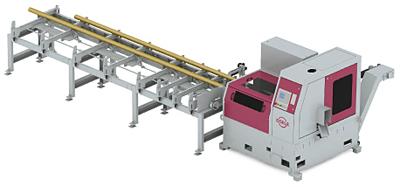
Behringer has added an automated inclined magazine to its HCS-90E carbide circular cold saw. The newly packaged HCS-90E now meets high production demands while minimizing the need for operator attendance. "Behringer has designed the HCS-90E saw for customers that literally need bulk cutting output in the thousands of pieces per day range," said Joe Suydam, Behringer sales and marketing associate.
A fully automatic high-performance circular cold saw, the HCS-90E is designed for cutting ferrous material at 90 degrees in maximum yield applications. High throughput performance is facilitated by the saw's inclined magazine which holds up to 3500 pounds of 12' long material. An optional extension expands material capacity to 20' long pieces and load capacity to 5250 pounds. Once loaded with bundles, the machine will run without interruption, cutting pre-programmed lengths, ejecting trim and remnants and channeling good cut pieces to a holding bin. This functionality is fully automatic without requiring operator standby.
"Depending on raw bar lengths, the number of bars on the inclined magazine and the finished cut lengths," said Suydam, "it's entirely possible that an operator who loads a bundle of material at the beginning of a shift would not need to attend the machine for the remainder of that shift."
The saw is equipped with a PLC, which permits programming the number of pieces to be cut, length, discharge handling and other parameters. Integrated sensor technology helps assure virtually non-stop throughput by detecting the leading and tail edge of the material being cut and automatically managing the feed rate. In this process, the back end of the material being cut travels past a light barrier in the machine. This signals the magazine to automatically load and stage the next bar onto a roller conveyor for entry into the saw. The machine will repeat this process until the supply of stock in the magazine has been exhausted.
The feed gripper unit is powered by a servo-driven ball screw spindle and encoder. This provides an infinitely variable feed or reverse feed rate of up to 39.3" per second. Single stroke capacity is 0.314" to 39.3" and multiple stroke is up to 393.6" (32.8'). To assure optimum alignment of material entering the gripper clamping area, Behringer added a material shifting device to the gripper feed unit. This facilitates smooth handling of material to help prevent marking or scratching and is beneficial for high volume jobs.
The HCS-90E blade diameters measure from 9.8" (250mm) to 12.4" (315mm). The saw uses long lasting carbide-tipped disposable blades to provide fast, precision cutting of round stock up to 3.5" (90mm) in diameter. A 10.7 HP frequency controlled saw motor enables blade speeds of 25 to 215 RPM which facilitates cutting high-alloyed heat resistant steels and other ferrous materials. The entire sawing head is mounted on pre-tensioned linear ways angled at 25 degrees and the worm gear driving the saw blade has been engineered for backlash-free motion. This enhances smooth cutting action and promotes long blade life.
Pressure-balanced, controlled blade movement helps maintain consistent production rates and improves cutting accuracy on both solid and tubular material. There is also an automatic material retract feature on the input side, and an automatic material release on the output side. This protects the carbide blade when the saw head returns to its "home" position after completing a cut. Behringer's robust machine design helps assure long blade life. Vibration absorbers mounted between the machine base and the sawing unit further enhance long blade life by eliminating vibrations which also enhances cut quality.
Contact Details
Related Glossary Terms
- feed
feed
Rate of change of position of the tool as a whole, relative to the workpiece while cutting.
- sawing
sawing
Machining operation in which a powered machine, usually equipped with a blade having milled or ground teeth, is used to part material (cutoff) or give it a new shape (contour bandsawing, band machining). Four basic types of sawing operations are: hacksawing (power or manual operation in which the blade moves back and forth through the work, cutting on one of the strokes); cold or circular sawing (a rotating, circular, toothed blade parts the material much as a workshop table saw or radial-arm saw cuts wood); bandsawing (a flexible, toothed blade rides on wheels under tension and is guided through the work); and abrasive sawing (abrasive points attached to a fiber or metal backing part stock, could be considered a grinding operation).
- sawing machine ( saw)
sawing machine ( saw)
Machine designed to use a serrated-tooth blade to cut metal or other material. Comes in a wide variety of styles but takes one of four basic forms: hacksaw (a simple, rugged machine that uses a reciprocating motion to part metal or other material); cold or circular saw (powers a circular blade that cuts structural materials); bandsaw (runs an endless band; the two basic types are cutoff and contour band machines, which cut intricate contours and shapes); and abrasive cutoff saw (similar in appearance to the cold saw, but uses an abrasive disc that rotates at high speeds rather than a blade with serrated teeth).







